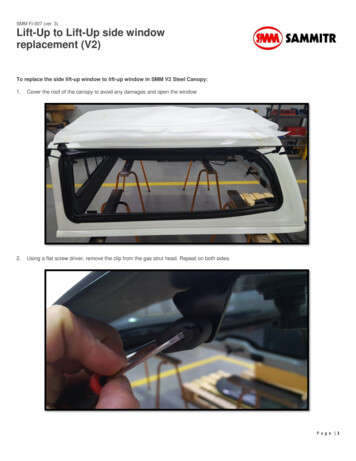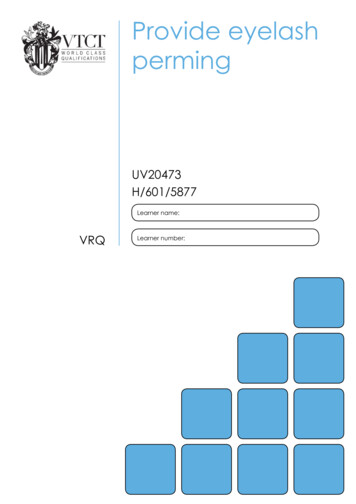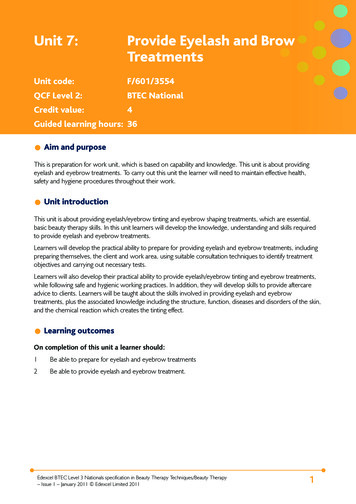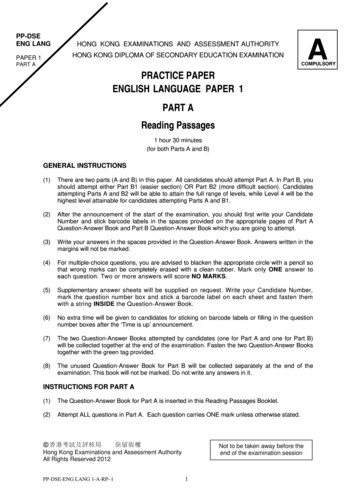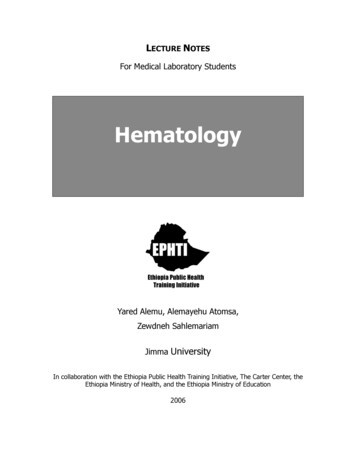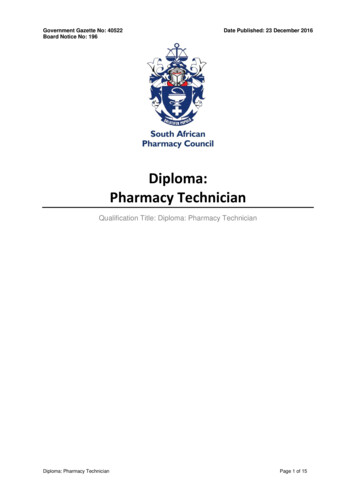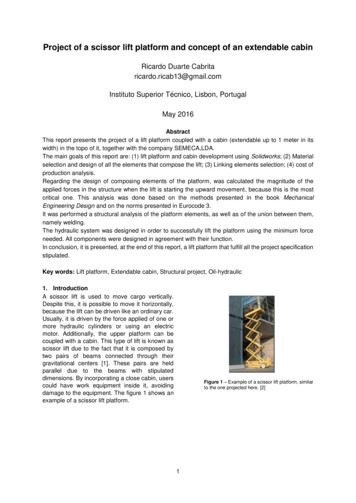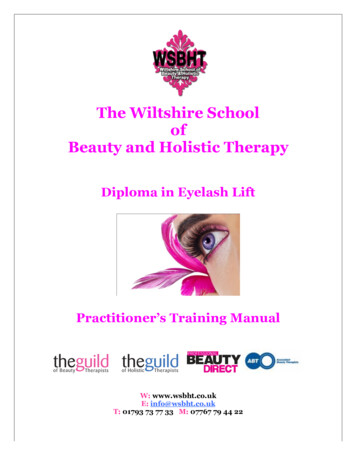
Transcription
The Wiltshire SchoolofBeauty and Holistic TherapyDiploma in Eyelash LiftPractitioner’s Training ManualW: www.wsbht.co.ukE: info@wsbht.co.ukT: 01793 73 77 33 M: 07767 79 44 22
CONTENTS1.Aims & Objectivesp32.Course Detailsp43.Eyelash Lifting Introductionp54.Hygiene, Health & Safetyp65.Professional Ethics & Standards of Practicep146.Related Anatomy & Physiologyp177.Client ionsp3110. Patch Testingp3311. Eyelash Liftingp3412. Aftercarep3813. Storage & Insurancep3914. Contact Detailsp4015. Self Assessmentp4116. Notesp4217. Accreditationp4318. Theory Assignmentp4419. Practical Assessmentp4520. Resultsp46The Wiltshire School of Beauty and Holistic TherapyDiploma in Eyelash Lift Training Manual 2
1. AIMS & OBJECTIVESAIMSThe aims of this course are to teach the student the basics of health and safety,and anatomy and physiology in relation to this course. This manual also coversthe background, benefits, treatments, consultation, contra-indications,contra-actions, aftercare, equipment and products needed. The student will alsolearn the movements and techniques required to perform a professionaltreatment during the practical sessions.OBJECTIVESThe objectives of this course are that by the end it the student will be able toperform a professional treatment in a safe and hygienic manner in acommercially acceptable time, along with experience of carrying out aconsultation with the knowledge of the background, benefits, consultation,contra-indications, contra-actions, aftercare, equipment and products needed.WSHBT advise you to read this training manual thoroughlyalong with other research before you take part in your practicalsession.The Wiltshire School of Beauty and Holistic TherapyDiploma in Eyelash Lift Training Manual 3
2. COURSE DETAILSDuring this course you will learn how to perform professional eyelash lifttreatments.You will learn how to: prepare the treatment areaprepare the client for treatmentcarry out a client consultationlift the eyelashes to meet the client’s requirementsprovide aftercare advice.You will also study: related hygiene, health and safetyrelated anatomy and physiologycontra-indicationscontra-actionslash lift procedures.You will attend a 4 hour training session to study the theory and practicalelements required to perform a professional eyelash lift treatments.Once you have successfully completed, you will receive The Wiltshire School ofBeauty and Holistic Therapy Diploma in Eyelash Lift.Good luck and enjoy!The Wiltshire School of Beauty and Holistic TherapyDiploma in Eyelash Lift Training Manual 4
3. EYELASH LIFT INTRODUCTIONIntroduction to Eyelash LiftFirstly, as the name suggests, it is literally ‘lifting of the eye lashes’This is a fantastic treatment which helps to emphasise the eyelashes, making theeyes look larger. Any length of lash can benefit from the shortest to the fullest andlongest.The lash lift takes approximately 45 mins to apply and can last for 6-8 weeks. Itssimilar to the eyelash perm but with much improved results. The lash lift systemuses a silicon shield (rather than old fashioned perm rods) and each natural lash islifted individually from the root giving the appearance of lift and volume to theeyelashes.The gentle lifting solution means that there is no risk of any long term side effectsto the lashes or their roots.It is a very safe treatment. The lashes remain lifted even when wet and will lashfor approximately 6-8 weeks.What happens during the treatment: Using a silicone shield and water solubleglue, the lashes are lifted and separated to help ensure a beautiful naturalappearance. Lifitng lotion is then applied to the lashes and left for up to 10minutes followed by the application of a neutraliser. This is then also left for upto 10 minutes. Finally, damp cotton wool is used to gently remove the shield, aconditioner is applied leaving you with beautiful enhanced lifted eyelashes.The Wiltshire School of Beauty and Holistic TherapyDiploma in Eyelash Lift Training Manual 5
4. HYGIENE, HEALTH & SAFETYMaintaining a high standard of hygiene is essential. Not only from a health andsafety perspective, but clients will not return if the salon, treatment area, orequipment are not clean.It is a legal requirement for employers to display an approved health and safetyposter or to supply employees with an equivalent leaflet or information.It is recommended that you get copies of the following from your local council: Health and Safety in the WorkplaceTrade Descriptions ActData Protection ActSales of Goods ActCOSSH Regulations and Risk Assessment (Control of SubstancesHazardous to Health)Local Government (Miscellaneous Provisions) Act 1982The Management of Health and Safety at Work Regulations 1992The Workplace Regulations 1992The Manual Handling Regulations 1992The Personal Protective Equipment at Work Regulations 1992The Health and Safety (Display Screen Equipment) Regulations 1992The Electricity at Work Regulations 1992Health and Safety (First Aid) Regulations 1981RIDDOR – The Reporting of Injuries, Diseases & Dangerous OccurrencesRegulations 1995Fire Precautions (Workplace) Regulations 1997Consumer Protection Act 1987.All businesses are required by law to comply with the following health and safetyacts, which are monitored and managed by The Health & Safety Executive (HSE)www.hse.gov.uk Health and Safety at Work Act 1974This protects your rights either as an employer or employee. The law statesthat the employer must provide a safe working environment, providehealth and safety training for staff, produce a written policy of thecompany’s health and safety policy, and ensure that anyone on theirpremises is not exposed to any health or safety risks.The Wiltshire School of Beauty and Holistic TherapyDiploma in Eyelash Lift Training Manual 6
Trade Descriptions Act 1972This act is particularly relevant to therapists as it relates to how the goodsor services are described in any kind of advertising or promotionalmaterial. The act makes it illegal to mislead the public in any way or makeany false claims about what you are able to do. Data Protection Act 1984This is only relevant if you are storing information about your clients on acomputer. If so, you must register your business on the Data Protectionregister. Sale of Goods Act 1994This act protects your clients’ rights by insisting that any goods or servicessold must be of a satisfactory standard, be suitable for the purposedescribed, accurately described, and provided in a reasonable time and fora reasonable price. Control of Substances Hazardous to Health Act (COSHH) 1989This act provides guidance on dealing with chemical substances that couldenter the body and cause skin irritations, allergies, burns etc. Local Government (Miscellaneous Provisions) Act 1982The local authority is responsible for registering and licensing anybusinesses where invasive treatments, i.e. body piercing, epilation,acupuncture take place on the premises. This is to ensure that allequipment is sterilised, only fully qualified therapists are carrying out thetreatments, waste products (especially needles) are disposed of correctly. The Management of Health & Safety at Work Regulations 1992This act outlines the responsibilities of the owner/manager of the businessto protect the well-being of all who visit the premises, to keep a record ofall checks they have made and also of any first aid treatments carried outon their premises. The Workplace Regulations 1992These regulations govern the appearance of all parts of the workplace, notjust the treatment rooms. This would include suitable toilet facilities whichare kept clean and tidy with adequate soap, towels, hot & cold runningwater etc. Proper ventilation, the areas are well lit, the area is at acomfortable temperature, is clear of all waste material (keep the walk waysclear of clutter), has up to date fire fighting equipment, has drinking wateravailable. The Manual Handling Regulations 1992This relates to the appropriate posture when lifting to reduce the risk ofinjury and to safely carry out manual tasks required in the workplace.The Wiltshire School of Beauty and Holistic TherapyDiploma in Eyelash Lift Training Manual 7
The Personal Protective Equipment at Work Regulations 1992This act requires you to provide the correct safety/protective equipment tocarry out a particular task. The Health & Safety (Display Screen Equipment) Regulations 1992These regulations are relevant to anyone using a computer and require youto get regular eye tests, take regular breaks, and use the correct heightadjusted chair. The Electricity at Work Regulations 1992This governs the use of electrical equipment in the workplace and ensuresthat any equipment is checked at least once a year by a qualifiedelectrician. Any faulty equipment is removed from service, and writtenrecords are kept should an inspector wish to see them. Health and Safety (First Aid) Regulations 1981No matter how small your business is there must be first aid treatmentavailable should an injury take place. RIDDOR – The Reporting of Injuries, Diseases & DangerousOccurrences Regulations 1995This outlines the correct procedure to adopt if a workplace accidentoccurs. An accident book is a must. Fire Precautions (Workplace) Regulations 1997This ensures that the safety of all those present is considered and plannedfor should a fire take place. Consumer Protection Act 1987This is designed to look after your clients’ interests and protect them fromany product deemed unsafe.Reporting AccidentsThe reporting of all accidents and near misses should be recorded in the AccidentBook, which should be kept with a first aid kit on the work premises.The following information should be recorded: Full name and address of the person(s) involved in the accident.Circumstances of the accident.Date and time of the accident.All details of what may have contributed to the accident.The Wiltshire School of Beauty and Holistic TherapyDiploma in Eyelash Lift Training Manual 8
Salon/Treatment Area Hygiene Clean the salon thoroughly, daily. Clean the treatment area before and after every client. Use clean fresh smelling towels for each client, (dirty linen must belaundered at a minimum of 60 C). Creams, lotion and sprays should be dispensed from purpose-specificpump or spray bottles where possible, otherwise use a clean disposablespatula to remove products from bottles/jars. Replace all lids after removing products from the bottles/jars. Sterilise all tools. Empty bins and dispose of contents accordingly. Check all the plugs and wires on electrical equipment and make sure theyconform to British Standards, and are professionally checked annually. Make sure all fire exits are clear and accessible. Make sure your client’s personal belongings are safe. Protect client’s clothing by using towels. The towels may also be used topreserve the client’s modesty during the treatment. Read all labels and follow all manufacturer’s instructions. Know the hazardous warning signs. Store products safely and in accordance with safety data sheets. Report any faulty equipment/goods to your supervisor or supplier. Have a first aid kit that complies with the Health and Safety (First Aid)Regulations 1981.The Wiltshire School of Beauty and Holistic TherapyDiploma in Eyelash Lift Training Manual 9
Sterilising EquipmentMicro-organisms that may cause disease must be controlled through cleaning,disinfection or sterilisation.SanitationThis greatly reduces the number of pathogenic bacteria. It is the lowest form ofdecontamination and is safe to use on the skin. This process will remove soil,dust, dirt and organic matter along with a large proportion of micro-organismsfrom an object.Sanitation/cleaning is essential before disinfection or sterilisation of instrumentsand equipment. This process can be carried out by applying sanitising sprays,soaps and gels directly onto the skin and equipment.DisinfectionThis greatly reduces the pathogenic bacteria on work surfaces. This method isnot suitable for the skin, hair or nails.Disinfection is used on floors, any work surfaces/station, walls and bowls etc.This process does not remove bacteria spores.SterilisationThis process kills all living organisms; sterile, in this context, means free livingdisease-causing micro-organisms and their spores. This is a difficult process tomaintain but should be carried out on all tools, especially if they have been incontact with blood.Several ways to sterilise the equipment: UV lightAn enclosed steel cabinet that emits UV light when closed to kill off anybacteria AutoclaveThis works in a similar way to a pressure cooker by heating the waterunder pressure to a temperature of 100 C, which kills all germs, and is oneof the most efficient methods. BarbicideThis is a liquid used to soak instruments; ammonia can be used as theliquid within the barbicide.The Wiltshire School of Beauty and Holistic TherapyDiploma in Eyelash Lift Training Manual 10
Personal Hygiene Clean, ironed, freshly laundered uniform Clean, flat, sensible shoes Clean, short, manicured nails Fresh breath Use of antiperspirant Neat make-up.Personal Protective Equipment (PPE)A new pair of disposable gloves should be put on immediately before each client ifrequired, and a disposable apron is advisable to protect clothing. Both should bedisposed of directly after the treatment.Hands must be washed before you put on the gloves and immediately after youhave removed and disposed of the gloves.How to hygienically remove disposable gloves after use:Step 1Hold your right hand out with the palm facing up.Step 2 Pinch a portion of the glove that covers the inside of your wrist on yourright hand. Use the thumb and index finger of your left hand.Step 3 Gently pull the glove down about half way over your palm, revealing theinside of the glove. Do not completely remove the glove. Let go of theglove after you pull it down over the palm.Step 4 Use your right thumb and index finger to repeat these steps on your lefthand. This time, you will pinch the outside of the glove above the innerportion of your left wrist and completely remove the glove on the lefthand. Continue holding the left glove with your right thumb and indexfinger.Step 5Pull up a portion of the right glove with your bare left thumb and indexfinger. Touch only the inside portion of the glove that has already beenrevealed.Step 6 Remove the right glove by pulling down with your left thumb and indexfinger. As you pull down, the left glove that has already been removedshould fold up inside the right hand glove.Step 7Dispose of the rubber gloves in a proper container. Gloves that were incontact with certain substances, e.g. chemicals and bodily fluids, cannotbe thrown away in public trash receptacles.The Wiltshire School of Beauty and Holistic TherapyDiploma in Eyelash Lift Training Manual 11
Single Use Items Single use items are items that can potentially be contaminated with bloodor other bodily fluids and are items that cannot readily be cleaned ordisinfected. For example, waxing spatulas, orange sticks, cotton wool,disposable underwear and paper towels. Single use items must be disposed0f after each use.Waste Disposal Non-contaminated waste is waste not contaminated with blood or otherbodily fluids, e.g. cotton wool and paper towels, and should be placed in acovered bin with a liner. This should be removed every day, sealed anddisposed of with the normal rubbish. Contaminated waste (clinical waste) is waste that is soiled with blood orother bodily fluids, e.g. intimate wipes and disposable pants used forintimate waxing procedures. This must be disposed of in a separate closedbin lined with a yellow medical bin liner and collected by the Council orapproved registered collection service to be disposed of in controlledconditions. Sharps bin, e.g. micro-lances, often used for the removal of ingrowing hairs, are also classed as contaminated waste and must be placedin a yellow sharps bin that complies with BS7320 and UN3291 standardsand disposed of in the same way.HepatitisHepatitis means liver inflammation. Around half of all acute cases of hepatitisare due to a viral infection. Several kinds of hepatitis virus can infect the liver, themost common being Hepatitis A and B. Hepatitis A is caught through the contamination of food and water withfaeces (stools) through poor personal hygiene or sanitation. Hepatitis B is spread through the exchange of blood and body fluids, andcan be caught through unprotected sex, unsterilised needles, a needle stickinjury (accidental puncture of skin by a used needle) or contaminatedblood products. Hepatitis C is also spread through the exchange of blood or bloodproducts. It is spread through sharing needles and needle stick accidents.It can also spread by blood transfusions given before September 1992,when screening for Hepatitis C was introduced. There are four other recognised hepatitis viruses, named from Hepatitis Dto Hepatitis G.The Wiltshire School of Beauty and Holistic TherapyDiploma in Eyelash Lift Training Manual 12
Hepatitis A and E cause only acute infection; Hepatitis B and C cause chronic(ongoing) illness; Hepatitis D is only present in people infected with Hepatitis B.Hepatitis can be caused by the glandular fever virus.Vaccinations are available for Hepatitis A and B (singly or combined), and also asa combination of Hepatitis A and Typhoid.There is a small risk of contracting the Hepatitis B virus from sharingtoothbrushes, razors or towels that may be contaminated with blood.Unsafe tattooing and body piercing practices also risk potentially spreading thevirus.It is recommended that all therapists have a vaccination against Hepatitis B.The Wiltshire School of Beauty and Holistic TherapyDiploma in Eyelash Lift Training Manual 13
5. PROFESSIONAL ETHICS & STANDARDSOF PRACTICEA Therapist should: maintain the highest standard of professional conduct. provide services in an ethical and professional manner in relation toclientele, business associates, health care professionals and the public. practice within the professional boundaries of the practitioners training. ensure client comfort and safety. protect client privacy. respect client confidentiality. maintain anonymity of the client when discussing the client’s case withother professionals, unless written consent is obtained. have adequate professional insurance. never claim to cure a condition. never treat a client with a condition that is contra-indicated to thetreatment. keep all records of treatments complete and up to date. explain the treatment and answer any questions and queries prior tocarrying out the treatment on the client. never treat a minor or disabled person without prior consent from a parentor carer. treat all clients in a professional manner at all times regardless of theircolour, sex or religion. refer clients to other professionals/GP where required.The Wiltshire School of Beauty and Holistic TherapyDiploma in Eyelash Lift Training Manual 14
Standards of PracticeThe practice of good ethics is essential to the reputation of the field of beautytherapists and the welfare of the clients and practitioners of the therapies. Thefollowing is a statement of standards and ethics for therapists, includingstandards of ethical and proper behaviour.A Therapist should: conduct herself/himself in a professional, honest, and ethical manner. promote professionalism. establish goals with each client and evaluate the outcome at the end ofeach session. promote the therapies within the community. promote therapies with healthcare professionals and other practitioners. truthfully and accurately represent their credentials, qualifications,education, experience, training and competence relevant to the practice. maintain confidentiality of the client. undertake continual professional development to enhance their skills.A Th
similar to the eyelash perm but with much improved results. The lash lift system uses a silicon shield (rather than old fashioned perm rods) and each natural lash is lifted individually from the root giving the appearance of lift and volume to the eyelashes. The gentle lifting solution
